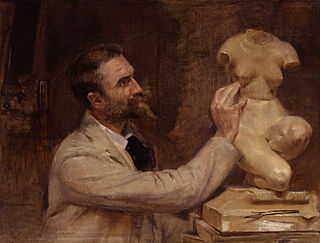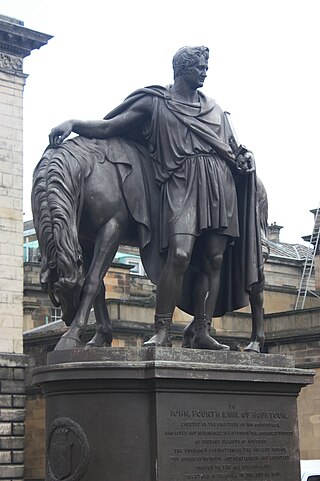Related Research Articles

Sir Joseph Edgar Boehm, 1st Baronet, was an Austrian-born British medallist and sculptor, best known for the "Jubilee head" of Queen Victoria on coinage, and the statue of the Duke of Wellington at Hyde Park Corner. During his career Boehm maintained a large studio in London and produced a significant volume of public works and private commissions. A speciality of Boehm's was the portrait bust; there are many examples of these in the National Portrait Gallery. He was often commissioned by the Royal Family and members of the aristocracy to make sculptures for their parks and gardens. His works were many, and he exhibited 123 of them at the Royal Academy from 1862 to his death in 1890.

Sir John Robert Steell was a Scottish sculptor. He modelled many of the leading figures of Scottish history and culture, and is best known for a number of sculptures displayed in Edinburgh, including the statue of Sir Walter Scott at the base of the Scott Monument.

Hiram Powers was an American neoclassical sculptor. He was one of the first 19th-century American artists to gain an international reputation, largely based on his famous marble sculpture The Greek Slave.

Edward Onslow Ford was an English sculptor. Much of Ford's early success came with portrait heads or busts. These were considered extremely refined, showing his subjects at their best and led to him receiving a number of commissions for public monuments and statues, both in Britain and overseas. Ford also produced a number of bronze statuettes of free-standing figures loosely drawn from mythology or of allegorical subjects. These 'ideal' figures became characteristic of the New Sculpture movement that developed in Britain from about 1880 and of which Ford was a leading exponent.

Baron Pietro Carlo Giovanni Battista Marochetti was an Italian-born French sculptor who worked in France, Italy and Britain. He completed many public sculptures, often in a neo-classical style, plus reliefs, memorials and large equestrian monuments in bronze and marble. In 1848, Marochetti settled in England, where he received commissions from Queen Victoria. Marochetti received great recognition during his lifetime, being made a baron in Italy and was awarded the Legion of Honour by the French government.

Mary Thornycroft was a British sculptor who sculpted many different busts, fragments and statues. She frequently choose infants and children as her subjects and was commissioned by Queen Victoria to create a number of statues and portraits of her children and other members of the Royal Family. Several of these are now in the British Royal Collection.

Sir Edgar Bertram Mackennal, usually known as Bertram Mackennal, was an Australian sculptor and medallist, most famous for designing the coinage and stamps bearing the likeness of George V. He signed his work "BM".

Alexander Munro was a British sculptor of the Pre-Raphaelite movement. He concentrated on portraiture and statues, but is best known for his Rossetti-influenced figure-group Paolo and Francesca (1852), which has often been identified as the epitome of Pre-Raphaelite sculpture.

John Evan Thomas, FSA was a Welsh sculptor, notable for many sculptures both in Wales and elsewhere in the UK, such as his portrait sculptures in London. He was especially notable for the Death of Tewdrig which was exhibited at the Great Exhibition of 1851, and for his two bronze statues of Henry de Loundres and William, Earl of Pembroke in the chamber of the House of Lords.
Alfred Gatley was an English sculptor.

Patric Park was a Scottish sculptor.

John Lawlor was an Irish sculptor and medallist, elected to the Royal Hibernian Academy in 1861. He spent most of his career working in London, specialising in poetic subjects and portrait busts. He is noted for various statues in London, his 1881 bronze statues of Patrick Sarsfield in the grounds of St John's Cathedral in Limerick, and the 1889 statue of Bishop Delany at St Mary's Cathedral in Cork.

Thomas Campbell was a Scottish sculptor in the early 19th century. He has several important public works, most notably a statue of Sarah Siddons in Westminster Abbey. He also has several works in the National Gallery in London. He was heavily patronised by the British aristocracy, as evidenced by his works.
Karin Margareta Jonzen, née Löwenadler, was a British figure sculptor whose works, in bronze, terracotta and stone, were commissioned by a number of public bodies in Britain and abroad.
Lilian Elizabeth A Griffith was a British artist who painted miniatures and created sculptures and portrait busts, plaques and medallions.

Baron Henri Joseph François de Triqueti, also spelt Henry de Triqueti, was a French sculptor and artist.
Emmeline Halse was a British sculptor known for her depiction of mythological subjects. She was a frequent exhibitor of such works at both the Royal Academy and in Paris during the late nineteenth century.

Agnes Freda Forres, Baroness Forres was a British artist known for her sculpture work in bronze and plaster.
Esther Mary Moore was a British artist known for her sculptures, metalwork and jewellery.
James Heffernan was an 18th/19th century Irish-born sculptor, later based in London.
References
- ↑ UK, Naturalisation Certificates and Declarations, 1870–1916
- 1 2 3 4 5 6 7 8 9 Delia Glaze (1997). Dictionary of Women Artists Volume 1 A-I . Fitzroy Dearborn Publishers. ISBN 1-884964-21-4.
- 1 2 3 4 5 6 Garrihy, Andrea. "Durant, Susan Durant". Oxford Dictionary of National Biography (online ed.). Oxford University Press. doi:10.1093/ref:odnb/59114.(Subscription or UK public library membership required.)
- 1 2 Benezit Dictionary of Artists Volume 4 Cossintino-Dyck. Editions Grund, Paris. 2006. ISBN 2-7000-3074-5.
- 1 2 "Susan D Durant". National Portrait Gallery. Retrieved 8 January 2020.
- 1 2 3 4 Sara Gray (2019). British Women Artists. A Biographical Dictionary of 1000 Women Artists in the British Decorative Arts. Dark River. ISBN 978-1-911121-63-3.
- 1 2 3 4 James Mackay (1977). The Dictionary of Western Sculptors in Bronze. Antique Collectors' Club.
- 1 2 3 University of Glasgow History of Art / HATII (2011). "Susan Durant". Mapping the Practice and Profession of Sculpture in Britain & Ireland 1851–1951. Retrieved 8 January 2020.